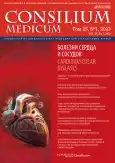The role of stress and sleep disorders in the development of cardiovascular complications in patients with arterial hypertension: what is important for an internist to know? A review
- Authors: Ionin V.A.1
-
Affiliations:
- Pavlov First Saint Petersburg State Medical University
- Issue: Vol 25, No 1 (2023): Cardiovascular diseases
- Pages: 15-19
- Section: Articles
- URL: https://journals.rcsi.science/2075-1753/article/view/131631
- DOI: https://doi.org/10.26442/20751753.2023.1.202133
- ID: 131631
Cite item
Full Text
Abstract
This publication discusses the mechanisms underlying the development of arterial hypertension on the background of stress, discusses the current problems of blood pressure control in patients with stress-induced sleep disorders, the clinical features of patients with hypersympathicotonia as the main mechanism for the development of arterial hypertension and blood pressure variability in patients with comorbid pathology, a diagnostic algorithm, as well as presenting current recommendations in the strategy for choosing the optimal antihypertensive therapy with the possibility of personalized choice in various clinical situations.
Full Text
##article.viewOnOriginalSite##About the authors
Valery A. Ionin
Pavlov First Saint Petersburg State Medical University
Author for correspondence.
Email: ionin.v.a@gmail.com
ORCID iD: 0000-0001-7293-1144
Cand. Sci. (Med.)
Russian Federation, Saint PetersburgReferences
- Kotseva K, de Backer G, de Bacquer D, et al. Lifestyle and impact on cardiovascular risk factor control in coronary patients across 27 countries: Results from the European Society of Cardiology ESC-EORP EUROASPIRE V registry. Eur J Prev Cardiol. 2019;26:824-35.
- Ezzati M, Lopez AD, Rodgers A, et al. Selected major risk factors and global and regional burden of disease. Lancet. 2002;360:1347-60.
- Lewington S, Clarke R, Qizilbash N, et al. Age-specific relevance of usual blood pressure to vascular mortality: A meta-analysis of individual data for one million adults in 61 prospective studies. Lancet. 2002;360:1903-13.
- Karmali KN, Persell SD, Perel P, et al. Risk scoring for the primary prevention of cardiovascular disease. Cochrane Database Syst Rev. 2017;3. doi: 10.1002/14651858.CD006887.PUB4
- Kivimäki M, Steptoe A. Effects of stress on the development and progression of cardiovascular disease. Nat Rev Cardiol. 2018;15:215-29.
- Rozanski A. Behavioral cardiology: current advances and future directions. J Am Coll Cardiol. 2014;64:100-10.
- Albus C, Waller C, Fritzsche K, et al. Significance of psychosocial factors in cardiology: update. 2018: Position paper of the German Cardiac Society. Clin Res Cardiol. 2019;108:1175-96.
- Schultz WM, Kelli HM, Lisko JC, et al. Socioeconomic Status and Cardiovascular Outcomes: Challenges and Interventions. Circulation. 2018;137:2166-78.
- Visseren FLJ, Mach F, Smulders YM, et al. 2021 ESC Guidelines on cardiovascular disease prevention in clinical practice. Eur Heart J. 2021;42:3227-337.
- Julius S, Palatini P, Kjeldsen SE, et al. Usefulness of heart rate to predict cardiac events in treated patients with high-risk systemic hypertension. Am J Cardiol. 2012;109:685-92.
- Williams B, Mancia G, Spiering W, et al. 2018 ESC/ESH Guidelines for themanagement of arterial hypertension. Eur Heart J. 2018;39:3021-104.
- Seravalle G, Facchetti R, Cappellini C, et al. Elevated heart rate as sympathetic biomarker in human obesity. Nutr Metab Cardiovasc Dis. 2022;32. doi: 10.1016/J.NUMECD.2022.07.011
- Fatani BZ, Al-Yahyawi H, Raggam AA, et al. Perceived stress and willingness to quit smoking among patients with depressive and anxiety disorders seeking treatment. Health Sci Rep. 2022;5. doi: 10.1002/HSR2.503
- Leone A. Smoking and hypertension: independent or additive effects to determining vascular damage? Curr Vasc Pharmacol. 2011;9:585-93.
- Hering D, Kucharska W, Kara T, et al. Smoking is associated with chronic sympathetic activation in hypertension. Blood Press. 2010;19:152-5.
- Prichard BNC. The use of moxonidine in the treatment of hypertension. J Hypertens. 1997;15. doi: 10.1097/00004872-199715011-00007
- Karlafti EF, Hatzitolios AI, Karlaftis AF, et al. Effects of moxonidine on sympathetic nervous system activity: An update on metabolism, cardio, and other target-organ protection. J Pharm Bioallied Sci. 2013;5:253-6.
- Бойцов С.А., Баланова Ю.А., Шальнова С.А., и др. Артериальная гипертония среди лиц 25–64 лет: распространенность, осведомленность, лечение и контроль. По материалам исследования ЭССЕ. Кардиоваскулярная терапия и профилактика. 2014;13(4):4-14 [Boytsov SA, Balanova YuA, Shalnova SA, et al. Arterial hypertension among individuals of 25–64 years old: prevalence, awareness, treatment and control. By the data from ECCD. Cardiovascular Therapy and Prevention. 2014;13(4):4-14 (in Russian)].
- Sanjuliani AF, de Abreu VG, Francischetti EA. Selective imidazoline agonist moxonidine in obese hypertensive patients. Int J Clin Pract. 2006;60:621-9.
- Karlafti EF, Hatzitolios AI, Karlaftis AF, et al. Effects of moxonidine on sympathetic nervous system activity: An update on metabolism, cardio, and other target-organ protection. J Pharm Bioallied Sci. 2013;5:253-6.
- Li M, Zhang XW, Hou WS, Tang ZY. Insomnia and risk of cardiovascular disease: a meta-analysis of cohort studies. Int J Cardiol. 2014;176:1044-7.
- Cappuccio FP, D’Elia L, Strazzullo P, Miller MA. Sleep duration and all-cause mortality: a systematic review and meta-analysis of prospective studies. Sleep. 2010;33:585-92.
- Magee CA, Kritharides L, Attia J, et al. Short and long sleep duration are associated with prevalent cardiovascular disease in Australian adults. J Sleep Res. 2012;21:441-7.
- Lo K, Woo B, Wong M, Tam W. Subjective sleep quality, blood pressure, and hypertension: a meta-analysis. J Clin Hypertens. 2018;20:592.
- Mansoor GA, White WB, McCabe EJ, Giacco S. The relationship of electronically monitored physical activity to blood pressure, heart rate, and the circadian blood pressure profile. Am J Hypertens. 2000;13:262-7.
- Johns MW. A new method for measuring daytime sleepiness: the Epworth sleepiness scale. Sleep. 1991;14:540-5.
- Hsieh CG, Martin JL. Short Sleep, Insomnia, and Cardiovascular Disease. Curr Sleep Med Rep. 2019;5:234.
- Ernsberger P, Graves ME, Graff LM, et al. I1-imidazoline receptors. Definition, characterization, distribution, and transmembrane signaling. Ann N Y Acad Sci. 1995;763:22-42.
- Переверзев А. Оригинальные и воспроизведенные лекарственные средства: действительно ли они сопоставимы? Акцент на моксонидин. РМЖ. 2021;29(9):6-10 [Pereverzev AP. Original and reproduced medicinal products: are they comparable? Emphasis on moxonidine. RMJ. 2021;9:6-10 (in Russian)].
Supplementary files






